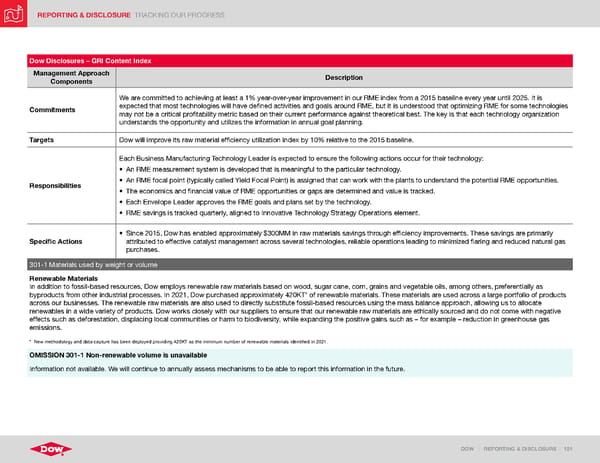REPORTING & DISCLOSURE TRACKING OUR PROGRESS DOW | REPORTING & DISCLOSURE | 121 Dow Disclosures – GRI Content Index Management Approach Components Description Commitments We are committed to achieving at least a 1% year-over-year improvement in our RME index from a 2015 baseline every year until 2025. It is expected that most technologies will have defined activities and goals around RME, but it is understood that optimizing RME for some technologies may not be a critical profitability metric based on their current performance against theoretical best. The key is that each technology organization understands the opportunity and utilizes the information in annual goal planning. Targets Dow will improve its raw material efficiency utilization index by 10% relative to the 2015 baseline. Responsibilities Each Business Manufacturing Technology Leader is expected to ensure the following actions occur for their technology: • An RME measurement system is developed that is meaningful to the particular technology. • An RME focal point (typically called Yield Focal Point) is assigned that can work with the plants to understand the potential RME opportunities. • The economics and financial value of RME opportunities or gaps are determined and value is tracked. • Each Envelope Leader approves the RME goals and plans set by the technology. • RME savings is tracked quarterly, aligned to Innovative Technology Strategy Operations element. Specific Actions • Since 2015, Dow has enabled approximately $300MM in raw materials savings through efficiency improvements. These savings are primarily attributed to effective catalyst management across several technologies, reliable operations leading to minimized flaring and reduced natural gas purchases. 301-1 Materials used by weight or volume Renewable Materials In addition to fossil-based resources, Dow employs renewable raw materials based on wood, sugar cane, corn, grains and vegetable oils, among others, preferentially as byproducts from other industrial processes. In 2021, Dow purchased approximately 420KT* of renewable materials . These materials are used across a large portfolio of products across our businesses. The renewable raw materials are also used to directly substitute fossil-based resources using the mass balance approach, allowing us to allocate renewables in a wide variety of products. Dow works closely with our suppliers to ensure that our renewable raw materials are ethically sourced and do not come with negative effects such as deforestation, displacing local communities or harm to biodiversity, while expanding the positive gains such as – for example – reduction in greenhouse gas emissions. * New methodology and data capture has been deployed providing 420KT as the minimum number of renewable materials identified in 2021. OMISSION 301-1 Non-renewable volume is unavailable Information not available. We will continue to annually assess mechanisms to be able to report this information in the future.
 ESG Report | Dow Page 120 Page 122
ESG Report | Dow Page 120 Page 122